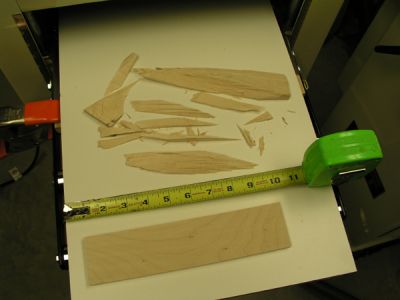Q.
Just a few quick questions for the guys who know a lot more about running moulding than I do:
How many thousandths should the pressure shoe be set below the finished profile thickness?
How many thousandths should the chip breaker be set below the finished profile thickness (assuming that .125Ē will be taken off when the stock reaches the top head)?
Iím running a Weinig Profomat 23E and since I bought the machine a year ago, Iíve been using my judgment for these settings. Everything has been going okay. Iím just wondering if there are any hard and fast rules out there I should be adhering to.
Forum Responses
On your shoe, align with the cutting circle then 1/8 - 1/4 turn down on the knob, this will be about 8-20/1000".
1/8" movement should be more than enough for the chipbreaker so leave it in line with the cutting circle. If it moves at all it should be fine--remember you can control movement of the chipbreaker to a great extent with your infeed table adjustment.
The less pressure on all elements including feed wheels, the better, as long as the timber is controlled as it moves through the machine.
You must also remember the above may need to be adjusted depending on a few variables, depth of cut, wood species, condition of knives, etc.
Lowering a chipbreaker any further does not significantly increase the pressure on the product. It may indeed hinder positive feeding.
Only a change of the spring or air pressure, in the case of some machines, will do that.
Spring rates are near constant unless they are variably wound or contain a change in wire diameter within the length. Good molders will take this into consideration, knowing the user may go from running 1" to 8" wide molding in the same shift.
Old machines sometimes solved this by providing an area for weighting pressure shoes and chipbreakers. I saw a Jerry rigged Mattison once with a 1" rod welded to the top chipbreaker whereon the stickerman placed circular weights. Yes, the same kind you lift.
According to the Thru Feed Moulder Manual, the pressure shoe is set in line with the smallest cutting circle of the tool and the chipbreaker is set 1/64" to 1/16" lower than the tool. This allows for the cases where the work piece is already to the correct thickness. As the amount of oversize of the work piece increases, the chipbreaker pressure increases. If this pressure becomes too great, then the chipbreaker should be raised slightly. Depending upon the feed speed of the machine, a spring-loaded or air loaded system is used.
For high feed rates over 150 fpm, an air system is normal.
The depth of the pressure shoe is normally set 1/16" or 1/4 turn of the adjustment knob.
It is critical to keep the pressure shoe level and to reduce the gaps around the tools to provide best control.
Dave Rankin, forum technical advisor
